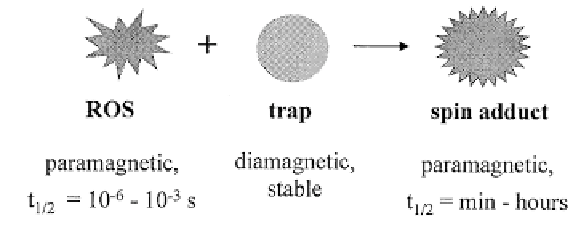Environmental Engineering Reference
In-Depth Information
Fig. 4. The principle of ROS detection by spin trapping EPR spectroscopy
One of these, DMPO [38] is of special importance, because DMPO-adducts
have characteristic EPR spectra, reflecting the chemical nature of the trapped free
radical. Experiments with the DMPO showed that various free radicals are produced
upon UV-B irradiation in photosynthetic organisms both
in vitro
and
in vivo
[39]. As
more purified preparations containing smaller functional subunits of photosystem II
showed mainly hydroxyl radical production (Hideg and Vass, unpublished), these ROS
appear as primary products. Beside hydroxyl radicals, more composite preparations
feature carbon centred free radicals, which are probably secondary ROS products. The
central role of hydroxyl radicals is supported by the observation, that the presence of
hydroxyl radical trap, POAN [40] at high concentration retarded UV-B induced protein
damage in isolated thylakoid membranes [41].
In leaves, EPR based ROS traps are difficult to apply directly, because the high
water content of the sample may hamper EPR measurements. Also, ROS probes
successfully applied in animal physiology may be metabolised in plants into inactive
forms [42]. Double (fluorescent and spin) sensors provide better possibilities. These are
fluorescent probes, containing a fluorophore and an ROS trap. Upon reacting with ROS,
the latter is converted into a nitroxide radical (leaving the possibility of EPR detection)
and causing structural changes which partly quench the probe's fluorescence [42,43].
The principle of double sensors is illustrated in Fig.5.
Using a double sensor, we have shown that although the two different aspects
of light stress, damage by excess photosynthetically active irradiation (photoinhibition)
and UV-B irradiation both result in damaging the function and structure of special part
(the reaction centre of photosystem II) of the photosynthetic apparatus, the oxidative
nature of the two processes is different [44].
Fluorescence from the double sensor can also be measured using laser scanning
microscopy. In this way, the non-invasive imaging technique makes spatial information
available on the production site of ROS (Hideg et al. 2001). In Fig.6, a comparison of
short exposure to photoinhibition by excess photosynthetically active radiation (PI) and
UV-B irradiation illustrates the difference. Stress conditions were chosen to result in

Search WWH ::

Custom Search